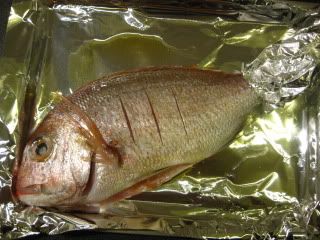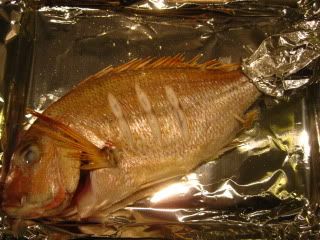
I got two beautiful Tai snappers. Just looking at them always makes me happy. I decided to use the smaller one to cook "Tai Meshi". It's a traditional Tai snapper rice dish. It's also one of Jason's favorite donabe rice dishes, so I make it for him sometimes. Over years, I've tweaked my Tai Meshi recipe multiple times, so the recipe below is my updated version. I concluded I like to cook this dish with dashi stock (kombu and katsuo-bushi base), so that the flavor becomes nicely enhanced without becoming overpowering.
For this, I used double-lid donabe rice cooker, "Kamado-san" (3 rice-cup size).


Cleaned Tai snapper was seasoned with salt first. It was then scored both sides and rubbed some olive oil. To prevent the tail from burning, only the tail was wrapped in foil and both sides were broiled just until the skin was lightly-browned.

Rice, dashi stock, and seasoning were put in "Kamado-san", and the whole fish was put on top. It was bigger than the donabe, so I just bent the tail upward (that's also a happy symbol!).


Voila. "Tai Meshi" was ready after cooking for about 15 minutes. After the head and bones were removed, the fish was fluffed with the rice and garnished with shredded ginger and mitsuba herb. After removing the head, I love eating the eye balls...they are so giggly and tasty. Rich in collagen!
Here's my update recipe:
Tai Snapper Rice ("Tai Meshi")
Ingredients:
1 (about 1 pound/ 450 g) whole Tai Snapper, cleaned
1 teaspoon salt
1/2 tablespoon olive oil
2 rice-cups (360 ml) short grain rice, rinsed and drained
1 1/4 cups (300 ml) dashi stock
2 tablespoons sake
1 tablespoon light-color soy sauce ("usukuchi shoyu")
1/4 teaspoon salt
some mitsuba herb, chopped
a knob ginger, sliced into needle-thin
some sansho pepper powder
Procedure:
For this, I used double-lid donabe rice cooker, "Kamado-san" (3 rice-cup size).


Cleaned Tai snapper was seasoned with salt first. It was then scored both sides and rubbed some olive oil. To prevent the tail from burning, only the tail was wrapped in foil and both sides were broiled just until the skin was lightly-browned.

Rice, dashi stock, and seasoning were put in "Kamado-san", and the whole fish was put on top. It was bigger than the donabe, so I just bent the tail upward (that's also a happy symbol!).


Voila. "Tai Meshi" was ready after cooking for about 15 minutes. After the head and bones were removed, the fish was fluffed with the rice and garnished with shredded ginger and mitsuba herb. After removing the head, I love eating the eye balls...they are so giggly and tasty. Rich in collagen!
Here's my update recipe:
Tai Snapper Rice ("Tai Meshi")
Ingredients:
1 (about 1 pound/ 450 g) whole Tai Snapper, cleaned
1 teaspoon salt
1/2 tablespoon olive oil
2 rice-cups (360 ml) short grain rice, rinsed and drained
1 1/4 cups (300 ml) dashi stock
2 tablespoons sake
1 tablespoon light-color soy sauce ("usukuchi shoyu")
1/4 teaspoon salt
some mitsuba herb, chopped
a knob ginger, sliced into needle-thin
some sansho pepper powder
Procedure:
- Season all sides including the cavity of the snapper with 1/2 tablespoon salt. Set aside for 20-30 minutes.
- Pat-dry the fish with paper towel. Make 3 slight incisions on each side of the fish crosswise with a knife. (Picture A)
- Drizzle the olive oil and rub on both sides of the fish. Wrap the tail with a piece of aluminum foil. Broil both sides until the skin is lightly browned (about 2 minutes each side). Remove foil fro the tail.
- Meanwhile, in "Kamado-san", combine the rice, dashi stock, sake, soy sauce, and salt. Let the rice soak in liquid for 20 minutes.
- Pat-dry the fish to remove excess oil and carefully lay it over the rice. If the fish doesn't fit, bend the tail upward. (Picture B)
- Cover "Kamado-san" with both lids and cook over medium-high heat for 13-15 minutes or until 2-3 minutes after the steam starts puffing from the top lid.
- Turn off the heat and let it stand for 20 minutes.
- Carefully remove the fish and transfer to a plate. Remove the head and bones from the fish and discard. (But you can eat the collagen-rich eye balls, like me!)
- Transfer the fish back to "Kamado-san" and gently fluff with the rice with a rice paddle. Garnish with some ginger and mitsuba. (Picture C) Serve into individual bowls and sprinkle some sansho pepper (if you like) to enjoy.
"Kamado-san" really makes this dish come out perfect with the pure and tender fish and perfectly-textured rice which absorbed all the essence from the fish. Between Jason and I, we often finish the whole donabe of Tai Meshi. It's that good.
Happy donabe life.
